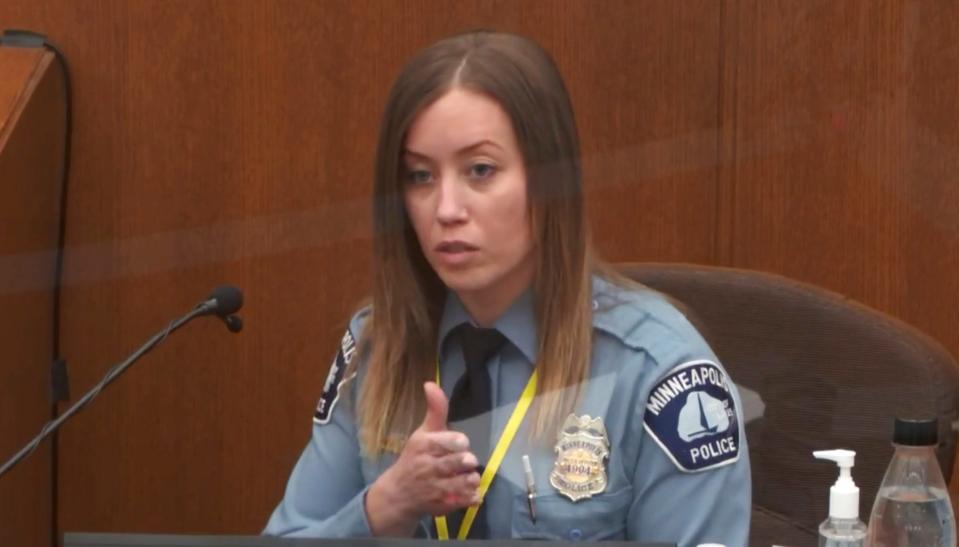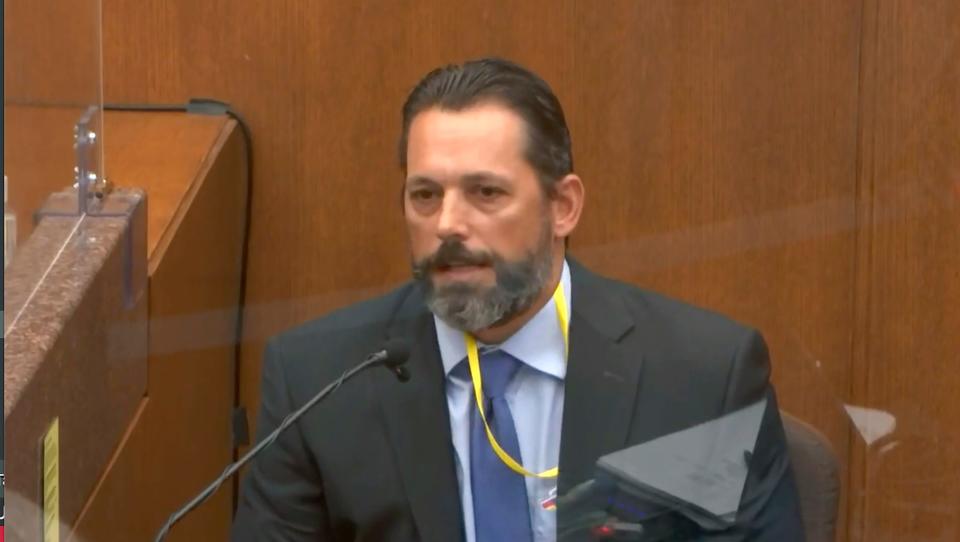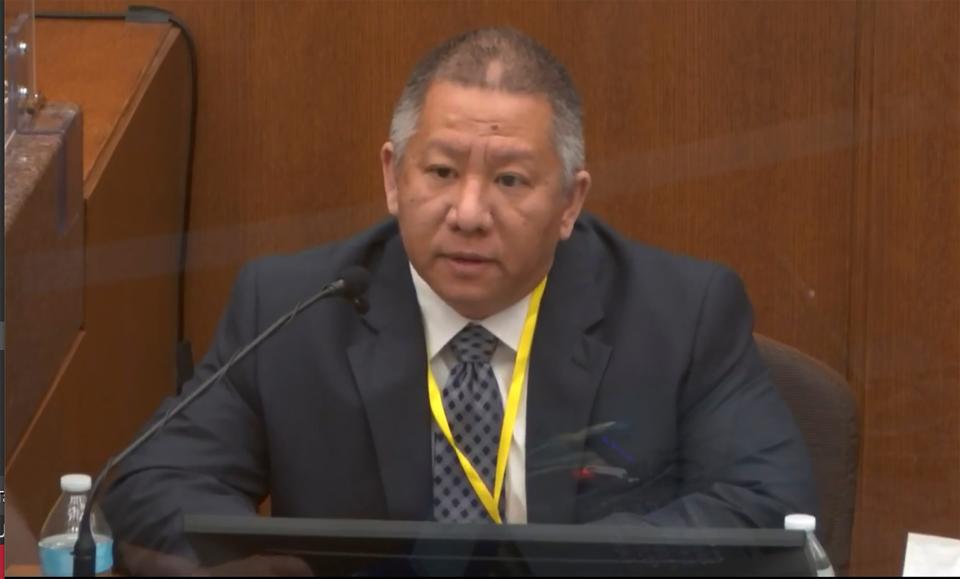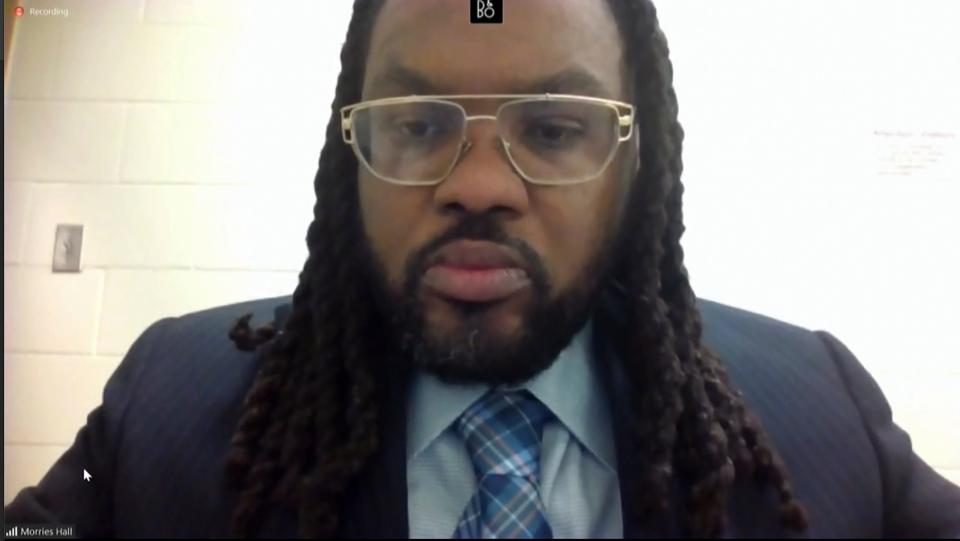Derek Chauvin trial, day 7: EMT says Minneapolis policy requires police to call ambulance, render medical aid in ‘critical’ situations
- Oops!Something went wrong.Please try again later.
- Oops!Something went wrong.Please try again later.
Follow Wednesday's coverage here.
MINNEAPOLIS — The EMT who leads the Minneapolis Police Department's emergency medical response training told jurors in the murder trial of Derek Chauvin that officers are trained to call for an ambulance and provide medical aid if a situation is "critical."
"If you don’t have a pulse on a person, you immediately start CPR," officer Nicole Mackenzie said Tuesday. "If it's a critical situation, you have to do both" CPR and call for an ambulance.
Officers who responded to George Floyd did not render medical aid, and Chauvin continued to keep his knee on Floyd's neck for more than two minutes after officers realized Floyd did not have a pulse, according to court records.
Earlier, Minneapolis police Lt. Johnny Mercil, a use-of-force expert, was presented with an image of Chauvin with his knee on Floyd's neck and told jurors the move was not a department-trained neck restraint.
The testimonies come a day after Minneapolis Police Chief Medaria Arradondo told jurors that Chauvin's restraint of George Floyd "absolutely" violated department policy. He said that the restraint should have stopped "once Mr. Floyd stopped resisting" and "once he was in distress and verbalized it."
Chauvin is facing murder and manslaughter charges. Floyd, a Black man, died in police custody on May 25, 2020, after Chauvin, who is white, pinned his knee against Floyd’s neck for more than nine minutes.
Stay updated on the Derek Chauvin trial: Sign up for text messages of key updates, follow USA TODAY Network reporters on Twitter, or subscribe to the Daily Briefing newsletter.
Latest updates:
Witness testimony was expected to resume after 9:15 a.m. CST Wednesday.
Rodney Floyd spoke to reporters Tuesday afternoon and said hearing his brother's last words replayed in court was "agonizng."
Sgt. Jody Stiger of the Los Angeles Police Department, an expert witness, told jurors he determined Chauvin's use of force was "excessive." Stiger has provided training to approximately 6,000 officers in de-escalation, basic patrol tactics and other subjects. He was expected to return to the witness stand Wednesday.
George Floyd’s brothers, family attorney Ben Crump, national civil rights leader Rev. Al Sharpton and Gwen Carr, the mother of Eric Garner, held a prayer service outside the courthouse Tuesday afternoon.
The first witness to testify Tuesday was Sgt. Ker Yang, crisis intervention training coordinator for the Minneapolis Police Department.
Earlier, Judge Peter Cahill instructed lawyers to draft questions for Morries Hall, the man who was in the vehicle with Floyd before his struggle with police officers. Hall filed a motion last month saying he would refuse to answer questions if he's forced to testify.
Rodney Floyd: Hearing brother's last words replayed in court is 'agonizing'
George Floyd’s brother Rodney spoke to reporters Tuesday afternoon and said the court proceedings have been "nail-biting."
"It’s like watching a movie. There’s so many ideas of what’s gonna happen," he said, mopping some sweat that gathered from his brow.
Rodney Floyd said the last time he was inside the courtroom was on the day when prosecutors played uninterrupted body-worn camera footage from different officers, showing his brother’s death over and over again.
That day, Rodney Floyd could be seen in the courtroom shaking his head from side to side and, at one point, glaring at Chauvin. When prosecutors played the first video, Floyd looked stoic and sad, hugging his midsection lightly and swiveling in his chair. He sat through the second, third, fourth videos of the incident, all from different angles.
"That was very, very hard," he said. "I don’t know where I grabbed the strength because it was back and forth like it was never gonna end."
Floyd said hearing his brother's voice on the recordings was "very painful." Floyd said his brother’s dying words from the videos were supplanting his memory of the last conversation they had, in which they reminisced about their late mother.
"When someone dies you cherish their last words, but my brother’s last words, oh, those words are stuck in my head. Agonizing," he said. "The only thing that makes sense to me is him calling for mother. ... The last conversation we had, he said mom was heavy on his mind. He’s a momma’s baby."
Expert witness Jody Stiger says Chauvin's use of force was 'excessive'
Prosecutors Tuesday afternoon called Sgt. Jody Stiger of the Los Angeles Police Department as an expert witness. Stiger has provided training to approximately 6,000 officers in de-escalation, basic patrol tactics and other subjects
Stiger told jurors that, after reviewing the case, he determined Chauvin's use of force was "excessive." He said he uses the "objectively reasonable" standard established in the 1989 U.S. Supreme Court case, Graham v. Connor.

Prosecutor Steve Schleicher led Stiger through the factors used to support that opinion, starting with a photo of Chauvin with his knee on Floyd's neck.
Stiger said he also examined the severity of the alleged offense, in this case, trying to pass a counterfeit $20 bill. In such a case, "you wouldn't even expect to use any kind of force," said Stiger.
Next, Stiger said he examined the threat posed by Floyd. In certain cases, the size and stature of the subject may be relevant in evaluating use of force. But Stiger testified that it is not appropriate to use force against someone simply because of his or her larger size.
Stiger testified the initial police use of force was appropriate, because Floyd was resisting arrest as officers tried to get him into the back seat of their patrol car. However, after the officers placed Floyd on the ground, "they should have de-escalated the situation, or attempted to," Stiger testified. Instead, he said, they continued to intensify the situation.
It was "not necessarily" required for the officers to use force to get Floyd into the car, Stiger testified. One officer had established a bit of rapport with Floyd, and the officers could have used that to try to talk Floyd into the car, Stiger testified.
After watching a video replay from one officer's body camera, Stiger acknowledged that Floyd kicked the officer's arms away one time as they struggled to control him.
Stiger's testimony was cut short when the judge dismissed the jury for the day, and he was expected to return to the witness stand Wednesday.
EMT Nicole Mackenzie: Officers must call ambulance, render aid if situation is 'critical'
Minneapolis Police Department officer Nicole Mackenzie, an EMT and the department's medical support coordinator, told jurors that officers are required to administer medical aid and call for an ambulance if a situation is "critical."
Mackenzie said officers receive CPR training every other year. Prosecutor Steve Schleicher posted CPR cards issued to Chauvin to show he had the necessary training.
Mackenzie said department policy instructs officers to check for a pulse and give and continue CPR until someone more senior is on the scene with advanced training, there are obvious signs of death or until the officer is completely exhausted.

Asked by prosecutor Steve Schleicher about whether someone who is speaking is always able to breathe, Mackenzie said: "Just because they're speaking doesn't mean they're breathing adequately."
In cross examination by defense attorney Eric Nelson, MacKenzie acknowledged some situations may prevent an officer from calling EMS.
Mackenzie's testimony was cut short as the defense said they planned to call her back, as early as next Tuesday, for their case.
Al Sharpton, Ben Crump lead brief prayer service outside courthouse
George Floyd’s brothers, family attorney Ben Crump, national civil rights leader Rev. Al Sharpton and Gwen Carr, the mother of Eric Garner, held a brief prayer service outside the courthouse Tuesday afternoon.
Crump said that watching the trial has caused post traumatic stress for the family and those watching on television, "young people especially." Crump added that autopsy photos of Floyd may be shown in court Tuesday, which would create "a different kind of heartache for the family."
.@TheRevAl said the family decided to have a public prayer service today because “so many are suffering” anxiety during the trial pic.twitter.com/RNyEZShzw6
— N'dea Yancey-Bragg (@NdeaYanceyBragg) April 6, 2021
Sharpton said the family often has private prayer sessions with him by phone, but decided to have a public prayer session Tuesday after "a tumultuous week" of witness testimony and repeatedly watching video of Floyd’s arrest. He led the group in a brief prayer to "set a tone of healing."
"We believe that if you stand for what’s right that you will give us justice," he said. "We wept through many cases from Rodney King to Eric Garner to Michael Brown some never reached the courthouse, but here we are now in the shadows of the courthouse praying for justice."
After Sharpton’s prayer, Floyd’s brothers — Philonise, Terrence and Rodney — thanked their supporters. "After we get the verdict and we get this conviction we’ll be able to breathe," Philonise Floyd said with his arm around Carr.

Johnny Mercil, use-of-force instructor: Officers weren't taught to put their knee on neck
Minneapolis police Lt. Johnny Mercil, who taught a use of force training class attended by Derek Chauvin in October 2018, took the witness stand Tuesday. Mercil, who heads the training division’s use of force lessons, told jurors that a still-image of Chauvin kneeling on Floyd’s neck is not a restraint taught to Minneapolis Police Department officers.
Mercil is a key witness because he's the first use-of-force expert the jurors have heard from, and he carries additional credibility because he is specifically familiar with and teaches Minneapolis Police Department use-of-force policies.
Mercil said using a knee on the neck or back can be an authorized use of force, but it's usually transitory and depends on the time frame and type of resistance. If the subject is handcuffed and not resisting, it is not authorized, Mercil said. Once the subject is handcuffed and compliant or not resisting, then it’s "an appropriate time" for the officer to move their knee, Mercil said.

"There’s the possibility and risk that some people have trouble breathing when they’re handcuffed (to their back) and on their stomach," Mercil said. A person is rolled on their side to prevent positional asphyxia, Mercil said. The officer should turn the person to this position "sooner the better," though he noted it depends on the situation and environment.
Officers should change their force if the force they’re facing changes to the situation upon reassessment, Mercil said.
Sanctity of life and the protection of the public is a cornerstone of the department’s use of force policy, Mercil said. Use of force includes applying a restraint, which must be reasonable, per the U.S. Constitution’s Fourth Amendment, and a 1989 Supreme Court case.
Force must also be proportional, which means it must be the least amount of force necessary to maintain control over a person and proportional to the level of resistance an officer is getting from the subject the officer is using force on, Mercil said. If it does not work, then more force may be allowed.
"If you can use a lower level of force to meet your objectives it’s better and safer for everyone involved," Mercil said. Prosecutor Steve Schleicher showed Mercil an image of Chauvin with his knee on Floyd's neck and asked if it showed the department-trained neck restraint. Mercil, who teaches officers physically how to do neck restraints, said it does not.
Under questioning by Chauvin's attorney, Eric Nelson, Mercil acknowledged use of force techniques do not have a strict application in every instance and that officers are taught to be fluid and react to the circumstances they face.
Nelson again, as he's done throughout the trial, painted the crowd faced by the officers as a threat, and Mercil agreed that the crowd's words could be considered threatening to the officers, and would be a factor they might consider.
Mercil also agreed under questioning that some people make excuses to avoid arrest, and that he has had suspects say "I can't breathe" when he was trying to arrest them.
Nelson posited that an officer could hold a neck restraint after rendering someone unconscious, perhaps to wait for another officer to arrive. Mercil agreed with that. However, Mercil declined to agree with the argument that Chauvin could hold the neck restraint while waiting for emergency medical services to arrive.
Arradondo, the police chief, said that Chauvin and his fellow officers violated department policy by failing to provide medical care to Floyd once he lost his pulse, while waiting for an ambulance.
Nelson showed Mercil the same image of Chauvin kneeling with his knee on Floyd’s neck. Mercil restated that this is not taught to officers, but that it can be similar to using body weight to control technique.
"However, we tell officers to stay away on the neck, and we tell officers to put it on their shoulder and be mindful of the position," Mercil said.
Presented with a still image from an officer's body-worn camera of an EMT palpating Floyd's carotid artery on his neck to check his pulse, Mercil said Chauvin's knee, at that point, "appears to be between the shoulder blades."
In the bystander video, which is filmed from another angle, Chauvin appears to slightly shuffle back to allow the EMT access to Floyd. At that point, based on the image, Mercil said Chauvin's use of force was not a neck restraint and appeared to be a body weight hold.
Mercil agreed he's trained officers to use their body weight to control a subject until emergency medical services arrives, "as long as it’s needed to control them."
Ker Yang, crisis intervention training coordinator: Records show Chauvin completed requirements
Sgt. Ker Yang answered questions from prosecutor Steve Schleicher on the witness stand Tuesday morning. The government's questioning was focused on showing that former Minneapolis police officer Derek Chauvin received specific training for the type of confrontation he ultimately faced with George Floyd in May 2020.
Yang confirmed records that show Chauvin completed a 40-hour crisis intervention training program in 2016 at the department's training division. He said the training is designed to enable officers to make decisions as they interact with people in crisis. The ultimate goal of such training, he said, "is to see if that person needs help," from medical personnel or other assistance.
"If someone is in need of medical attention, then we give him medical attention," Yang said, referring to a Minneapolis police officer’s duty to act to provide care for a person in custody. He also agreed that a person who is intoxicated by alcohol or drugs could be in crisis.

During cross-examination of Yang, defense attorney Eric Nelson repeated a line of questioning he used Monday with Minneapolis Police Chief Medaria Arradondo. The questioning reminded jurors that Chauvin and other officers struggled with Floyd and simultaneously received criticism from bystanders who watched and filmed the struggle.
Nelson drew Yang’s agreement that observing police actions to arrest and subdue a suspect could prompt a crisis for some civilian bystanders who watch the process.
Responding to Nelson, Yang agreed that crisis-intervention training would include teaching officers "how to determine when citizens" observing police actions "pose a threat or risk." Nelson also drew Chang to acknowledge that "sometimes police actions can look pretty bad."
However, during re-questioning of Yang, Schleicher got the officer to agree that a police officer's assessment of a suspect's medical situation during a confrontation would be "a big thing," while a 17-year-old filming that confrontation would be "a small thing."
Morries Hall, who was in vehicle with George Floyd, appears before the court
Judge Peter Cahill won't immediately let a man who was in a car with George Floyd avoid testifying in the trial of former police officer Derek Chauvin.
Cahill instructed defense and government lawyers to draft narrowly tailored questions for Morries Hall, who appeared before the court Tuesday via Zoom. He is being held at the Hennepin County Public Safety Facility on unrelated charges.
Hall has been subpoenaed to appear as a witness by both the Chauvin defense and the government. However, Hall filed a motion late last month to quash the subpoena on grounds that he would invoke his Fifth Amendment right against incrimination and refuse to answer questions if he's forced to testify.

The judge said he would schedule another hearing after Hall has an opportunity to review the questions with Adrienne Cousins, an assistant public defender representing Hall.
Hall's name came up in questioning last week. Lead defense attorney Eric Nelson asked Floyd's girlfriend, Courteney Ross, about Hall. Ross acknowledged that she told FBI investigators Floyd bought narcotics from Hall, but in court she said she "did not see it with my own eyes."
Ross said she was in a car at a hotel while Floyd bought pills a week before his death. She said she was on the phone with him and thought she heard Hall's voice in the background. She testified that she only learned afterward that Floyd was with Hall the day Floyd died.
Minneapolis Police Chief Medaria Arradondo: Restraint of Floyd 'absolutely' violates policy
Minneapolis Police Chief Medaria Arradondo, who fired Derek Chauvin and three other officers involved in the incident, said Monday under questioning that he believed Chauvin was trying to employ a conscious neck restraint on Floyd, which involves using light to moderate pressure on a person who is actively resisting police, according to the department's policy.
But while viewing a still-frame of Chauvin kneeling on Floyd's neck, Arradando said from the picture and Floyd's facial expression, it "does not appear in any way, shape or form, that that is light to moderate pressure." Arradando added: "I vehemently disagree that that's the appropriate use of force for that situation."
The restraint should have stopped "once Mr. Floyd stopped resisting" and "once he was in distress and verbalized it," Arradondo said. He added that "there's an initial reasonableness in trying to get him under control in the first few seconds" only.
"And clearly when Mr. Floyd was no longer responsive and even motionless, to continue to apply that level of force to a person proned out, handcuffed behind their back. That in no way shape or form is not backed by policy, it is not backed by our training, and it’s certainly not our ethics or our values," Arradondo said.
Arradondo said the officers violated department policy by failing to give first aid to Floyd when he appeared to not be breathing, while they waited for an ambulance.
On cross-examination by defense attorney Eric Nelson, Arradondo acknowledged that he had not made an arrest, personally, in many years. He also acknowledged that in a side-by-side comparison of bystander video and an officer's body-cam video, it appears that in the latter, Chauvin's knee is more on Floyd's shoulder blade than on his neck.
The moment in the video came at the end of the incident, after paramedics arrived and checked Floyd's neck for a pulse. In the body-cam video, Chauvin can be seen shifting his knees and leaning back slightly.
Doctor tells jurors he believed lack of oxygen, not overdose or heart attack, was 'most likely' cause of death
Dr. Bradford Langenfeld testified Monday morning, telling jurors he directed the care of Floyd at Hennepin County Medical Center and spent about 30 minutes trying resuscitate him before pronouncing him dead.
Questioned by prosecutor Jerry Blackwell, Langenfeld said the paramedics who brought Floyd to the hospital did not give him any information that Floyd might have overdosed on drugs or suffered a heart attack.
Langenfeld said Floyd had some electrical activity around the heart, but no pulse. Floyd's heart never resumed beating on its own "to a degree necessary to sustain life," he said.
Asked by Blackwell what was determined to be the cause of Floyd's cardiac arrest, Langenfeld said: "At the time, based on the history available to me, I felt that hypoxia was one of the most likely possibilities." Hypoxia is a lack of oxygen, which Langenfeld said he believed led to Floyd's death from asphyxia.
During cross-examination by lead defense attorney Eric Nelson, Langenfeld acknowledged that a combination of fentanyl and methamphetamine could cause hypoxia. A toxicology screen of Floyd after his death found fentanyl and methamphetamine in his system.
This article originally appeared on USA TODAY: Derek Chauvin trial day 7: EMT, more police testify about training

